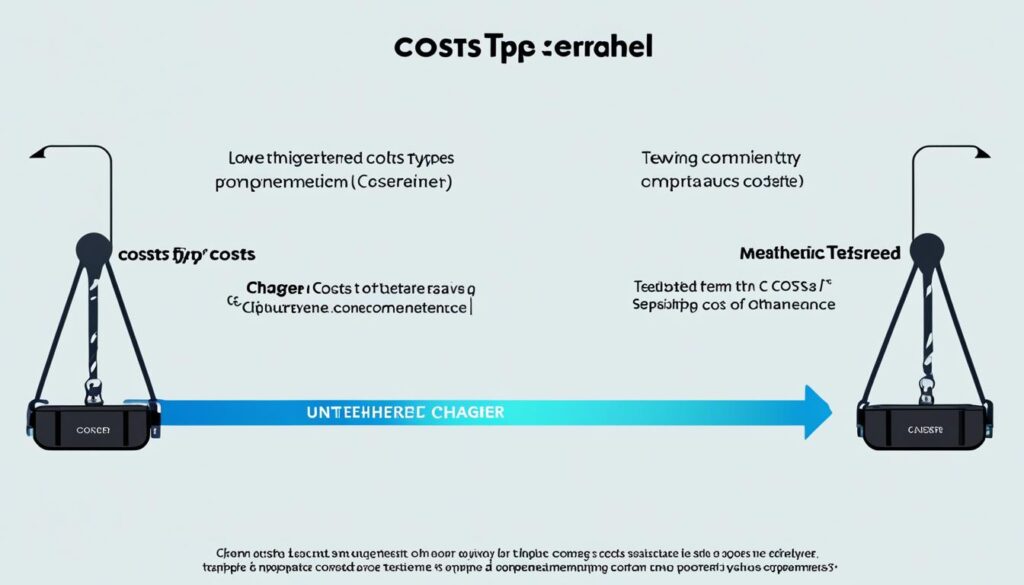When it comes to installing an EV charger at home, one important decision to make is whether to opt for a tethered or an untethered charger. Understanding the differences between the two can help you choose the right option for your needs.
The main distinction between tethered and untethered EV chargers lies in the charging cable. Tethered chargers come with a fixed cable already attached, while untethered chargers have a detachable cable. This fundamental difference leads to various pros and cons for each type.
Key Takeaways:
- Tethered EV chargers have a permanently attached charging cable, providing convenience and reducing the risk of misplacing the cable.
- Untethered EV chargers offer more flexibility as they allow you to use different cables and take them with you when traveling.
- The cost of tethered chargers is generally higher due to the included cable, while untethered chargers may require additional purchases of compatible cables.
- Security-wise, tethered chargers offer better theft protection, while some untethered chargers provide additional security features.
- Ultimately, the choice between tethered and untethered chargers depends on individual preferences, needs, and usage patterns.
Tethered EV Charger Overview
Tethered EV chargers are the most common type of home charger used for electric vehicles. These chargers are known for their convenience as the charging cable is permanently attached, making it a hassle-free option for charging your car.
The length of the cable provided by the manufacturer may vary, so it’s important to check if it suits your needs. Tethered chargers are available in two main charging connection types: Type 1 and Type 2. It’s crucial to select the correct type that is compatible with your vehicle.
Tethered EV chargers offer several advantages. Firstly, the cable attached to the charger is less likely to be stolen compared to untethered chargers, providing added security. Additionally, the fixed cable eliminates the need to find or store a separate charging cable, making it more convenient for home charging.
Key Features of Tethered EV Chargers:
- Permanently attached charging cable
- Compatibility with Type 1 and Type 2 charging connections
- Convenient for home charging
- Reduced risk of cable theft
“Tethered EV chargers provide a seamless charging experience, ensuring that your vehicle remains powered and ready for your on-the-go adventures.” – Electric Vehicle Magazine
| Tethered EV Charger | Type of Charging Connection | Advantages |
|---|---|---|
| Tethered Charger Type 1 | Type 1 | Compatible with vehicles that have a Type 1 charging port |
| Tethered Charger Type 2 | Type 2 | Compatible with vehicles that have a Type 2 charging port |
Untethered EV Charger Overview
Untethered EV chargers offer a new level of convenience and flexibility for electric vehicle owners. Unlike tethered chargers that have a permanently attached charging cable, untethered chargers allow you to use different cables, including the one provided with your car. This flexibility enables you to adapt to various charging situations, whether at home or on the go.
One of the key advantages of untethered chargers is their future-proof design. With rapidly evolving technology in the electric vehicle industry, being able to replace the charging cable is essential. Whether you need a longer cable or a different connection type, untethered chargers make it easy to upgrade and adapt, ensuring compatibility with future electric vehicle models.

Moreover, the ability to take the charging cable with you when traveling provides added convenience. You can use your own cable to charge your vehicle at public charging stations, eliminating the need to rely on various charging cables provided by different networks. This saves you time and ensures a seamless charging experience wherever you go.
In terms of aesthetics, untethered chargers offer a cleaner and more organized look. With no permanently attached cable, you can neatly store it away when not in use, reducing clutter and maintaining a sleek appearance in your garage or driveway. This storage option not only enhances the overall aesthetics but also protects the cable from weather exposure, prolonging its lifespan.
In summary, untethered EV chargers provide the flexibility and future-proofing needed in today’s electric vehicle landscape. Their compatibility with different charging cables, ability to adapt to future technologies, and aesthetic appeal make them a compelling choice for electric vehicle owners. Embrace the untethered approach to charging, and enjoy the freedom it brings to your electric vehicle journey.
Cost Comparison: Tethered vs Untethered
When choosing between a tethered EV charger and an untethered EV charger, one important factor to consider is the cost. Tethered chargers generally come at a higher price point compared to untethered chargers due to the inclusion of the charging cable. On the other hand, untethered chargers may require additional costs for purchasing a compatible charging cable separately.
If you own an electric car, it’s worth noting whether your vehicle comes with its own charging cable. In some cases, the car manufacturer provides a charging cable as part of the vehicle package, which can help reduce the need for purchasing an additional cable. This can be a significant cost-saving factor when considering the overall cost difference between tethered and untethered chargers.
The specific model and additional features of the charger can also impact the cost comparison. It’s important to research and compare prices from different manufacturers to make an informed decision that aligns with your budget and charging needs.
| Tethered EV Charger | Untethered EV Charger |
|---|---|
| Higher initial cost | Potential additional cost for purchasing a charging cable |
| No need to purchase a separate charging cable | May require the purchase of a compatible charging cable |
| Dependent on the specific model and additional features | |
Ultimately, the cost comparison between tethered and untethered EV chargers depends on various factors. While tethered chargers may have a higher upfront cost, they eliminate the need to purchase a separate charging cable. Untethered chargers, on the other hand, offer more flexibility but may come with additional costs for the cable. It’s essential to consider your budget, charging requirements, and the overall value and convenience each type of charger provides before making a decision.

Security Comparison: Tethered vs Untethered
When it comes to the security of your EV charger, choosing between a tethered and untethered charger can make a significant difference. Tethered chargers, with their permanently attached cable, provide better theft protection compared to untethered chargers.
Why is this the case?
Tethered chargers have the advantage of a fixed cable that is less likely to be stolen. The cable is permanently connected to the charger unit, making it difficult for thieves to remove. This adds an extra layer of security and peace of mind, especially if your charging station is installed in an exposed or public location.
On the other hand, untethered chargers have detachable cables that can be at a higher risk of theft. The ability to disconnect the cable makes it more susceptible to theft, as it can be easily removed from the charger unit when not in use.
It’s worth noting that not all untethered chargers lack security measures. Some manufacturers have introduced additional security features to mitigate the risk of cable theft. These features include pin protection or cable locking mechanisms, which prevent unauthorized access to the charger cable.
For optimal security, it is recommended to detach the cable from your untethered EV charger and store it out of sight when not in use. Keeping the cable securely stored can help prevent opportunistic theft and ensure the longevity of your charging equipment.
Conclusion
After weighing the pros and cons of tethered and untethered EV chargers, it is clear that both options have their advantages and considerations. Tethered chargers offer convenience, eliminating the need to find and store a separate charging cable. They also provide an added level of security, as the permanently attached cable is less likely to be stolen.
However, tethered chargers have limitations in terms of cable length and charging connection types. This means that if you need a longer cable or a different connection type in the future, you may need to replace the entire charger.
On the other hand, untethered chargers offer flexibility and future-proofing. With a detachable charging cable, you have the freedom to use different cables, including the one provided with your electric vehicle. This flexibility is especially useful when traveling or using other public chargers.
In addition, untethered chargers provide a more aesthetic appearance, as the cable can be neatly stored away when not in use. However, it is worth mentioning that untethered chargers require extra steps for plugging and unplugging the cable, which may be seen as a minor inconvenience by some.
Ultimately, the choice between a tethered and untethered EV charger depends on your personal preferences, needs, and how you plan to use the charger. Consider factors such as convenience, flexibility, security, and cost when making your decision. By carefully evaluating these factors, you can choose the EV charger that best suits your requirements and enables you to enjoy the benefits of electric vehicle ownership.











Am J Cardiol 83 1408 1411 how to buy priligy in usa reviews which started its final episodes with a record high of 5